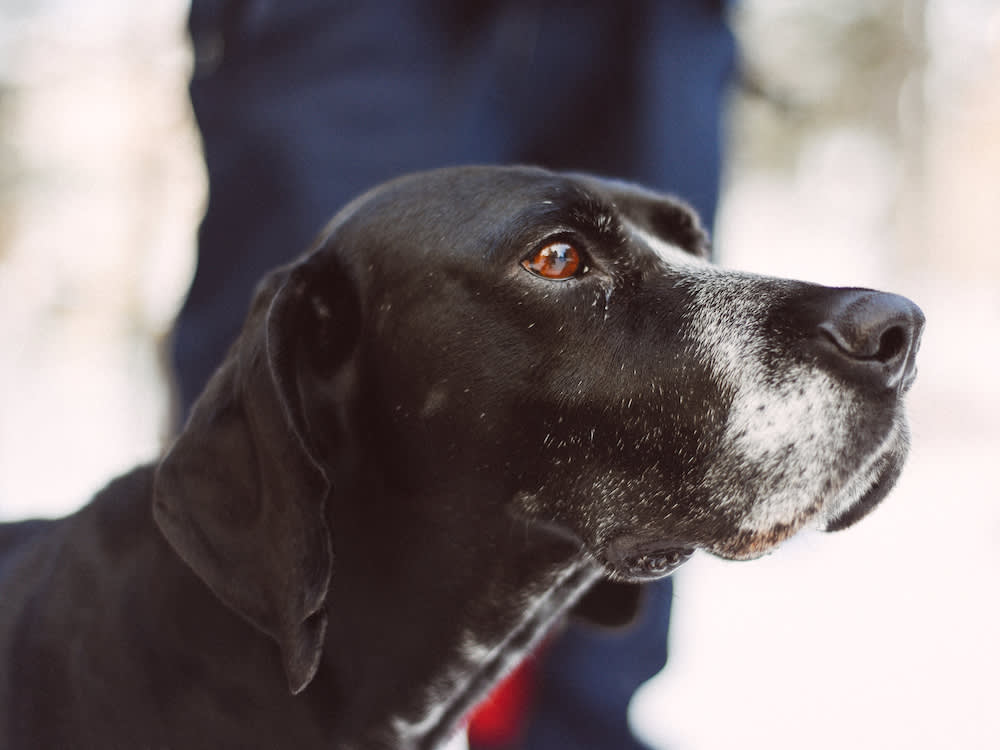A New Drug Could Make Your Dog Live Longer—Meet the Woman Who Created It
The founder and CEO of Loyal, Celine Halioua, tells Kinship what the future of pet parenthood could look like, starting with more time with your pup.
Quick question: Who wants their dog to live forever? The answer: everyone. Well, we have some news on this front — some good, some bad.
First, the bad: There is, in fact, no way to make your dog literally live forever — but you already knew that, right? Now, for the good news: There may soon be a way for your pup to live a healthier, longer life thanks to one Silicon Valley company that is currently developing a drug targeted at canine aging. It’s set to be on the market in 2025, which, in the grand scheme of things, isn’t so far away.
Snap a pic of your pup’s teeth, and GREENIES™ will help you spot potential signs of oral health issues.
As Kinship reported last week, biotech company Loyalopens in new tab and its founder and CEO Celine Halioua opens in new tab have developed an experimental drug called LOY-001 that has been determined by the Food and Drug Administration (FDA) to have a “reasonable expectation of effectiveness.” LOY-001 targets a hormone in large dogs that may contribute to their increased mortality.
Because we are pet people who are very interested in anything that will help our dogs live longer, we chatted with Halioua — currently dog-mom to Della, a Rottweiler she rescued as a senior — for insight into the drug and how it could transform pet parenthood. “Anybody who claims they can radically extend lifespan is making unproven claims,” she says. “I’m really hoping we can show the side of [medicine] that I’m passionate about, which is helping people and giving them hope.”
How much do you spend on your pet per year?
Halioua, who studied neuroscience at the University of Texas, Austin and economics of gene therapeutics at Oxford University, grew up in Texas surrounded by animals. “I grew up seeing cats, dogs, ferrets, hamsters, birds — a whole lot,” she says. “So yes, I am a huge animal person.” Her passion for nurturing pets is so infectious that her company has raised more than $60 millionopens in new tab in venture capital.
All of this is to say we have many, many questions — from what this means for cats and smaller dogs to the cost of obtaining them.
Why is your research focused on dogs rather than cats?
This is actually the number one question I get. Fundamentally, there were a couple of challenges: Cats live a really long time, which is great, but that makes seeing if an aging drug works very difficult. Cats are also little biological aliens. Things that might work on a human or a dog will sometimes have weird, unintended consequences, just because they’re a bit phylogenetically further away from us than dogs are. We do really want to work on cats at some point, but it’s just infeasible at this stage.
How did you know that drugs targeted at canine aging would be an achievable goal?
The thing a lot of people don’t realize about the biology of aging is that we’re nowhere near curing aging — nor do I think curing aging is possible. But the basic biological ways by which we age, and by which I’d say complex organisms age, is actually pretty well understood. So again, nothing we’re developing is going to cause radical lifespan extension.
But it’s improving quality of life?
Another way to think about it is that it’s preventative medicine. So, it’s a drug that you take while the patient is relatively healthy to keep that patient relatively healthy longer by counteracting the ways in which a patient ages unhealthily over time that leads to these diseases like cancer, Parkinson’s, Alzheimer’s.
In a human, to logistically do that is incredibly difficult. Humans live a very, very long lifetime. If I gave you an aging drug today, it would take potentially decades to see if it has any benefit. It also doesn’t fit into our current healthcare system, which is much more reactive, at least in the United States.
So, it’s easier to do this for dogs.
It’s still technically difficult, but the logistical challenges are nearly ameliorated. Dogs live a much shorter lifespan, especially big dogs, which is what we’re starting with. You can see biological aging in about six months, which makes the feedback loop pretty reasonable. And dogs kind of have a single-payer healthcare system that’s very aligned with preventative care, because a dog’s health insurance is their owner.
A dog owner is much more inclined to do preventative medicine. And of course we want our dogs to be healthier longer, because we can see the aging process. Everybody has a story of their beloved dog slowing down, not walking as fast, losing energy over time.
Which drugs do you have in development?
We have two drugs in development. One is for big dogs’ short lifespan. The bigger a dog is, the shorter their average lifespan. So, a Great Dane might live six to nine years, while a Chihuahua might live 16 to 18 years. When you go on these dog forums…people are like, “I can’t handle the heartbreak of such a short lifespan of this dog.” This is actually a negative consequence of historical inbreeding, when we bred dogs for size.
We accidentally gave dogs this “disease” that causes them to age faster and die sooner. I’m not gonna say that’s completely fixable, but at least it can be mitigated with medicine. [The second drug] is for dogs of any size, of any breed, that are older. The only bad news is that for most tiny toy breeds, it’s a little bit more difficult from a dosing perspective. But the vast majority of dog sizes should be eligible for a Loyal product.
Are you focusing on specific diseases?
If your dog gets canine cognitive dysfunction, canine doggy dementia, or gets cancer or osteoarthritis, it’s not like one day the dog is healthy and the next day the dog has this disease. It’s a process that often develops over the years in a dog’s life, because the body is breaking down or losing resilience over time. The idea is that we’re targeting the way the dog declines from a healthy middle age to a more frail dog, and try to keep those healthy years going longer. So, we’re very explicitly not targeting any specific disease.
When we think of a startup, we think of scientists obviously, but are you working with actual veterinarians?
Yeah, we have a ton of vets on the team. There’s three parties we need to think about. There’s the science, and the science being legitimate. There’s veterinarians, and the medicines we’re developing being medically relevant to them, because they are ultimately the ones that will prescribe the drug products. And then there [are] the pet parents. The drug needs to do something for the pet parent that proves it’s worth the money that they’re spending. So we try to have all three groups represented within the company.
And we’re working on manufacturing the drug at scale, which takes a very long time to get the manufacturing procedures right. But it’s super important that every single bottle of pills are exactly the same, regardless of if you’re buying them in Alaska or Florida.
What will the price be when they hit the market?
We don’t have finalized price points, but it’s not going to be a quote-unquote rich person drug. That’s actually really important to me, personally. The idea of the drug is that we want it to be priced [in an accessible way] to the vast majority of pet parents in the United States. It’ll be in line with what other veterinarian products charge. I think somewhere between $30 and $60 a month.
We fall so madly in love with our dogs that we want them to live forever. How much of a game changer will this be on that front?
I don’t know [yet]. I will say that in model organisms — so in mice where the scientific community has done studies similar to what we’re doing with dogs — have shown significant lifespan extensions. Think: a double-digit percentage increase, relative to the average lifespan.
There’s also one study that was done by Purinaopens in new tab in the ’90s where they calorically restricted the dogs. Caloric restriction is one way to improve metabolic fitness and improve the fitness of the animal which is what we’re trying to do with our drugs. And they showed a two-year lifespan extension in Labradors.
Which ethical considerations did you contemplate upon starting Loyal?
I think an aging drug is not any more or less ethical than a drug for cancer, right? Because it’s targeting the same thing, just a different stage of its development. And it’s targeting it in a way that allows it to reduce suffering for the pet parent and the dog but also hopefully be more effective in mitigating that negative disease. So, I don’t think there’s an ethical challenge here, unless somebody thinks that medicine itself is unethical.
It’s been reported that a lot of what you’re doing now could positively help human beings, too. Can you explain how?
We have this incredibly unique relationship with dogs. We’ve evolved with them, we share an environment with them for tens of thousands of years. And they developed the same age-related diseases as we do at approximately the same time in our lifespans. So, if something works in a dog, it’s not one-to-one to work in a human. Absolutely not. But there is much more compelling evidence that it may work in people instead of, for instance, a mouse.
And what does that timeline look like?
Candidly, that’s kind of a million-dollar question. I think the way to think about it is: We’re first and foremost focused on getting our dog-aging drugs to market. And we’re also committed to learning everything we can from our dog-aging drugs to help people.














